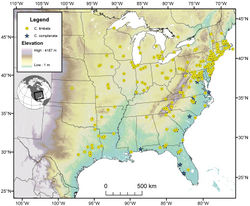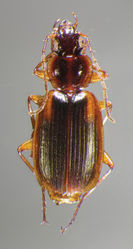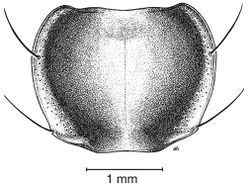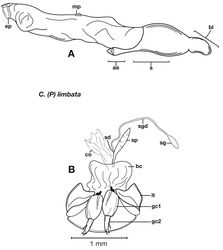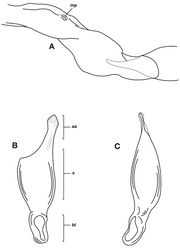Cymindis limbata
| Notice: | This page is derived from the original publication listed below, whose author(s) should always be credited. Further contributors may edit and improve the content of this page and, consequently, need to be credited as well (see page history). Any assessment of factual correctness requires a careful review of the original article as well as of subsequent contributions.
If you are uncertain whether your planned contribution is correct or not, we suggest that you use the associated discussion page instead of editing the page directly. This page should be cited as follows (rationale):
Citation formats to copy and paste
BibTeX: @article{Hunting2013ZooKeys259, RIS/ Endnote: TY - JOUR Wikipedia/ Citizendium: <ref name="Hunting2013ZooKeys259">{{Citation See also the citation download page at the journal. |
Ordo: Coleoptera
Familia: Carabidae
Genus: Cymindis
Name
Cymindis limbata Dejean – Wikispecies link – Pensoft Profile
- Cymindis limbata Dejean 1831[1]: 32, HOLOTYPE in Chaudoir/Oberthür Collection, labeled “ limbata m” and “ Latreille” (Lindroth 1955[2]: 24). TYPE LOCALITY. – Marion, Plymouth County, Massachusetts, U.S.A. (restricted by Lindroth 1969[3]: 1067, from “ l’ Amérique septentrionale”, the original type area). – LeConte 1848[4]: 189.
- Pinacodera limbata (Dejean 1831[1]); Schaum 1857[5]: 294. – LeConte 1861[6]: 24. – Chaudoir 1875[7]: 3. – Horn 1881[8]: plate 8, figure 97. – 1882[9]: 147 and 162. – Wickham 1909[10]: 8. – Blatchley 1910[11]: 152. – Leng 1915[12]: 588. – Casey 1920[13]: 279. – Notman 1928[14]: 239. – Brimley 1938[15]: 125. – Fattig 1949[16]: 40. – Lindroth 1955[2]: 24. – 1969[3]: 1067–1068. – Kirk 1969[17]: 16. – 1970[18]: 17. – Ciegler 2000[19]: 119.
- Planesus laevigata Motschulsky 1864[20]: 297. – TYPE LOCALITY – Mobile, Mobile County, Alabama, U.S.A.
- Pinacodera laevigata (Motschulsky, 1864); Horn 1882[9]: 162. – Casey 1920[13]: 295. – Lindroth 1969[3]; 1067-1068.
- Planesus fuscicollis Motschulsky 1864[20]: 298. TYPE AREA. – southern United States.
- Pinacodera fuscicollis (Dejean 1831[1]); Horn 1882[9]: 148, 162. – Casey 1920[13]: 285. – Lindroth 1969[3]: 1067.
Notes about synonymy
Lindroth (1969[3]: 1067) stated that the types of Cymindis laevigata and Cymindis fuscicollis are probably in the Zoological Museum of Moscow University (these types were listed at ZMMU by S. I. Keleinikova 1976[21]). He had not seen them, and questions the synonymy of these names and with Cymindis limbata Dejean. I note also that in 1829, some two years before the description of Cymindis limbata Dejean, T. W. Harris had correspondence with fellow entomologist N. M. Hentz in which he referred to a Cymindis specimen from his collection that had an “ochreous elytral margin, with a humeral lunule of the same color” (Harris 1869[22]). He refers to the specimen as Cymindis comma. In 1835, the name Cymindis comma appeared again in a list of the insects of Massachusetts that Harris compiled (Hitchcock 1835). I believe it likely that Harris was referring to what is now known as Cymindis limbata but because the 1829 correspondence was not published until 1869, and was not a formal description, the name Cymindis comma is not valid.
Diagnosis
Adults of Cymindis limbata are distinguished from those of other species by: a pale, testaceous humeral macula (Fig. 8) extended from interval 6 (rarely from interval 5) to the outer margin and posteriorly as far as one quarter (0.25) the length of the elytra; pronotum broadly rounded; antennomere 8, 3.0–3.9 × longer than wide. In males, genitalia with endophallus having a distinct sclerotized patch (Fig. 10A, 11A) medially, phallus apex with distinct curvature to the left when viewed from dorsal aspect (Fig. 11C); phallus apex broadly pointed and distinctly shaped (Fig. 10A, 11B). In females, gonocoxite 2 (gc2) long and narrow, sharply pointed at apex; apical ensiform setae curved outward and extended almost to gonocoxite apices (Fig. 10B).
Description
With character states of subgenus Pinacodera restricted as follows: OBL. 8.33 – 10.92 mm. Length (n= 20 males, 20 females): head 0.72 – 0.96, pronotum 1.52 – 2.16, elytra 4.62 – 6.41 mm; width: head 1.48– 2.00, pronotum 2.00 – 2.88, elytra 3.21 – 4.75 mm.
Body proportions. HW/HL 1.78 – 2.18; PWM/PL 1.26 –1.46; EL/EW 1.35 –1.52.
Metepisternum. Individuals show proportions of a minimum of 1.73× as long as wide.
Hind wings. Macropterous.
Color. Dorsum of head brunneous to rufo-piceous; pronotum brunneous to rufo-piceous on disc, margins sometimes in some specimens lighter; dorsum of elytra brunneo-piceous, margins somewhat paler, testaceous humeral macula extended from interval 6 (rarely interval 5) to the outer margin, and as far as one quarter the length of the elytra; antennae brunneo-testaceous to brunneous; palpi brunneo-testaceous to brunneo-piceous; epipleura testaceous to brunneo-testaceous; thoracic sclerites and abdominal sterna testaceous to piceous (apical edge of abdominal sterna in many specimens darker than basal edge).
Microsculpture. Microlines not visible on dorsum of head capsule and pronotum at 50× magnification. Elytra with mesh pattern isodiametric, microlines clearly defined throughout dorsal surface.
Macrosculpture and pilosity. Head capsule with very fine, randomly scattered setigerous punctures on dorsal surface (setae not visible or only barely so at 50× magnification) from constriction of neck extended anteriorly toward clypeus. Elytra with striae moderately impressed and punctulate throughout length; intervals slightly convex (few with greater convexity in intervals 1, 3 and 5); one or two (most specimens one) irregular rows of fine punctures extended length of intervals 1, 3 and 5; two or three (most specimens two) irregular rows of fine punctures extended the length of intervals 2, 4 and 6; interval 8 with two to four rows of fine punctules extended interval length. Abdominal sterna with fine pilose punctures throughout.
Fixed setae. Pronotum with two setae along each margin. Elytra with 15 or 16 lateral (umbilical) setae; two setae on each of abdominal sterna III to VI; four setae along apical margin of sternum VII (Fig. 3).
Luster. Elytra glossy
Head. Eyes, labrum, labium, palpi, typical for Cymindidina.
Pronotum. Anterior transverse impression shallow (Fig. 9); posterior transverse impression moderately deep; median longitudinal impression moderately shallow, posteriolateral angles obtuse to almost rounded.
Elytra. Humeri broadly rounded; striae moderately impressed; lateral margin smooth, rounded and widened preapically; apex truncate (Fig. 8). Legs. Males with adhesive vestiture ventrally, two rows of squamo- setae on tarsomeres 1–4 of foreleg and 1–3 of middle leg.
Male genitalia. Phallus apex curved to left when viewed from dorsal aspect (Fig. 11C), apex pointed in lateral aspect (Fig. 11B). Ventral and dorsal surface of apical area slightly dimpled (Fig. 11B) (most specimens) or not, few specimens with vertical striations (absent from most specimens) extended from mid length of apical area to apex of phallic shaft (s). Endophallus with microtrichial patch (mp) at midlength of the endophallus sac. Endophallus with a curved endophallic plate (ep) (Lindroth 1969[3]: 1080–1081) apically when viewed ventrally in everted condition.
Female genitalia. Gonocoxite 2 (gc2) long and narrow (Fig. 10B), sharply pointed at apex, curved outward; apical ensiform setae curved out slightly and extended almost to apex. Internal genitalia with long cylindrical spermatheca (sp), moderately long associated spermathecal gland (sg), and moderately long spermathecal diverticulum (sd) located at base of spermathecal gland duct (sgd).
Habitat, habits and seasonal occurrence
The known elevational range of Cymindis limbata extends from sea level to 1935 m. Specimens have been collected on and under bark, in leaf litter and from under stones in forests of oak, pine, tamarack, aspen, beech-magnolia and maple. Specimens have been found near creek and pond margins, among beach wash-up and have also been collected from squirrel nests in trees. Adults are crepuscular or nocturnal with most activity being observed on tree trunks. Adults are most commonly collected from May to August. Most teneral adults were found from late June to early July, suggesting emergence from pupal case also occurs around this time.
Methods of collecting include asafetida and molasses bait traps, sugaring baits painted on tree trunks, beating and sweeping vegetation, at incandescent light and u.v. light, Malaise traps, Lindgren funnels, Berlese traps, flight intercept traps (FIT’s), pitfall traps, and hand collecting.
Geographical distribution
The range of this species (Fig. 7) extends in eastern Canada from southern Quebec west to southern Ontario, and in the eastern United States east of the Appalachian Mountains from Maine south to southern Florida, west to eastern Colorado and Nebraska, and south to southern Texas.
Chorological affinities
Cymindis limbata is sympatric in the northern and western portion of its range with Cymindis platicollis platicollis, in the southeastern portion of its range with Cymindis platicollis atripennis and Cymindis rufostigma, and in the central portion of its range with Cymindis complanata.
Fossil specimens
Fossil packrat (Neotoma sp.) middens have been used to determine late Quaternary insect assemblages in the Chihuahuan desert areas of northern Mexico and southwestern Texas (Elias 1992[23], Elias and Van Devender 1992[24], Elias et al. 1995[25]). Particularily relevant to this treatment are middens examined from the Trans Pecos and Bolson de Mapimi areas where both Cymindis limbata and Cymindis platicollis subfossils had been reported (Elias 1992[23]). These species are primarily warm-temperate deciduous forest-adapted eastern species and currently both have southwestern range limits that do not extend to the Trans Pecos and Bolsom de Mapimi areas. Unfortunately, the specimens were unavailable for reexamination but in their place Scott Elias graciously sent me two S.E.M. images (a pronotum and a single elytron) of the putative Cymindis limbata fossils.
I was able to determine that neither fossil specimen was Cymindis limbata, based on examination of these images. First, The fossil image of the pronotum has narrowly bordered pronotal margins and hind angles that are almost right-angled. This contrasts with the pronotum of Cymindis limbata, whichtypically has a widely explanate margin and hind angles that are rounded, or at least widely obtuse. As well, I have not observed Cymindis limbata with deep punctures either side of the median longitudinal impression of the pronotum, a feature characteristic of the fossil specimen. The S.E.M. specimen appeared to be a lebiomorph carabid and I thought it to be a member of the genus Calleida so I sent the information to carabidologist Achille Casale (University of Sassari, Italy) who has detailed knowledge of the Mexican Calleida fauna. He confirmed that the pronotum was “Calleida-like” and appeared not to belong to Pinacodera (Casale 2008[26], personal communication).
The S.E.M. of the single fossil elytron also differed from that of Cymindis limbata. The width of the fossil elytron was more than 5 mm whereas Cymindis limbata elytra range from 3.2 to 4.75 mm. Additionally, Cymindis limbata typically have more than one row of shallow and fine punctures in the even elytral intervals and more than one row in interval 8. The fossil specimen has a single row in all intervals, which are obviously deeper and farther apart than observed in Cymindis limbata. After considering these discrepancies I believe it more likely that the elytron belongs to Cymindis punctigera punctigera LeConte as it is similar in size and morphological characteristics, and was found within the limits of the current geographical range of Cymindis punctigera punctigera. Cymindis punctigera punctigera has been collected in the recent past from nests of packrats of the genus Neotoma (Say and Ord 1825[27]).
Material examined
I have examined 1001 specimens of Cymindis limbata: 432 males and 569 females. For details see University of Alberta Strickland Virtual Entomology Museum Database (University of Alberta 2009[28]).
Taxon Treatment
- Hunting, W; 2013: A taxonomic revision of the Cymindis (Pinacodera) limbata species group (Coleoptera, Carabidae, Lebiini), including description of a new species from Florida, U.S.A. ZooKeys, 259: 1-73. doi
Other References
- ↑ 1.0 1.1 1.2 Dejean P (1831) Spécies general des coléoptères de la collection de M. le comte Dejean, vol. 5, Paris, 883.
- ↑ 2.0 2.1 Lindroth C (1955) The carabid beetles of Newfoundland including the French islands St. Pierre and Miquelon. Opuscula Entomologica Supplementum 11: 1-160.
- ↑ 3.0 3.1 3.2 3.3 3.4 3.5 Lindroth C (1969) The ground beetles (Carabidae excl. Cicindelinae) of Canada and Alaska. Part 6. Opuscula Entomologica, Supplementum 35: 945-1192.
- ↑ LeConte J (1848) A descriptive catalogue of the geodephagous Coleoptera inhabiting the United States east of the Rocky Mountains. Annals of the Lyceum of Natural History of New York 4: 173-474. doi: 10.1111/j.1749-6632.1848.tb00277.x
- ↑ Schaum H (1856–1860) (1857). Naturgesichte der Insecten Deutschlands. Erste Abtheilung. Coleoptera Erste Band. Nicolaische Verlagsbuchhandlung, Berlin, 791 pp.
- ↑ LeConte J (1861) Classification of the Coleoptera of North America. Prepared for the Smithsonian Institution. Smithsonian Miscellaneous Collections 136: 1-208.
- ↑ Chaudoir M (1875) Genres aberrants du groupe des cymindides. Bulletin de la Société Impériale des Naturalistes de Moscou vol. 49, pt. 2, pp. 1–61
- ↑ Horn G (1881) On the genera of Carabidae with special reference to the fauna of boreal America. Transactions of the American Entomological Society 9: 91–196, illus.
- ↑ 9.0 9.1 9.2 Horn G (1882) Synopsis of the species of the tribe Lebiini. Tranactions of the American Entomological Society 10: 126–164, illus.
- ↑ Wickham H (1909) A list of the Coleoptera of Iowa. Bulletin from the Laboratories of Natural History of the State University of Iowa 6: 23-24.
- ↑ Blatchley W (1910) The Coleoptera or beetles of Indiana. Bulletin of the Indiana Department of Geology and Natural Resources No. 1, 1–1386, illus.
- ↑ Leng C (1915) List of the Carabidae of Florida. Bulletin of the Amerian Museum of Natural History 34: 555-601.
- ↑ 13.0 13.1 13.2 Casey T (1920) Random studies among the American Caraboidea. In: Casey TL, Memoirs on the Coleoptera, Vol IX. New Era Publishing Company, Lancaster, Pennsylvania, 133–299.
- ↑ Notman H (1928) Carabidae. In: Leonard MD (Ed) The Insects of New York (Cornell University, Ithaca New York, 207–252.
- ↑ Brimley C (1938) The insects of North Carolina. North Carolina Department of Agriculture, Division of Entomology, Raleigh.
- ↑ Fattig P (1949) The Carabidae or ground beetles of Georgia. Emory Univesity Museum Bulletin No. 7. 1–62.
- ↑ Kirk V (1969) A list of the beetles of South Carolina Part 1- northern coastal plain. South Carolina Agricultural Experiment Station Technical Bulletin 1033: 124-148.
- ↑ Kirk V (1970) A list of the beetles of South Carolina. Part 2—mountain, piedmont, and southern coastal plain. South Carolina Agricultural Experiment Station Technical Bulletin 1038: 1-117.
- ↑ Ciegler J (2000) Ground beetles and wrinkled bark beetles of South Carolina (Coleoptera: Geadephaga: Carabidae and Rhysodidae). South Carolina Agriculture and Forestry Research System, Clemson University, 149.
- ↑ 20.0 20.1 Motschulsky T (1864) Enumération des nouvelles espèces de coléoptères rapporté de ses voyages. Bulletin de la Société Impériale des Naturalistes de Moscou 37(2): 171–240, 297–355.
- ↑ Keleinikova S (1976) V. I. Motschulsky’s types of Coleoptera in the collection of the Zoological Museum MGU. 1. Carabidae. Archives of Zoological Museum Moscow State University 15: 183-224.
- ↑ Harris T (1869) Entomological correspondence of Thaddeus William Harris MD. In: Scudder SM (Ed) Occasional papers of the Boston Society of Natural History 6 (1): 81-82.
- ↑ 23.0 23.1 Elias S (1992) Late Quaternary zoogeography of the Chihuahuan Desert insect fauna, based on fossil records from packrat middens. Journal of Biogeography 19 (3): 285-297. doi: 10.2307/2845452
- ↑ Elias S, Van Devender T (1992) Insect fossil evidence of Late Quaternary environments in the northern Chihuahuan Desert of Texas and New Mexico: comparisons with the paleobotanical record. The Southwestern Naturalist vol. 37 (2): 101-116. doi: 10.2307/3671658
- ↑ Elias S, Van Devender T, De Baca R (1995) Insect fossil evidence of Late Glacial Holocene environments in the Bolson De Mapimi, Chihuahuan Desert, Mexico: comparisons with the paleobotanical record. PALAIOS 10 (5): 454-464. doi: 10.2307/3515047
- ↑ Casale A (2008) Personal communication.
- ↑ Say T, Ord G (1825) A new genus of Mammalia proposed and a description of the species upon which it is founded. Journal of the Academy of Natural Sciences of Philadephia. 4 (2): 345-349.
- ↑ University of Alberta (2009) E. H. Strickland Virtual Entomology museum Database. Retrieved August 25, 2009, Web site: http://www.entomology.museums.ualberta.ca/
Images
|

